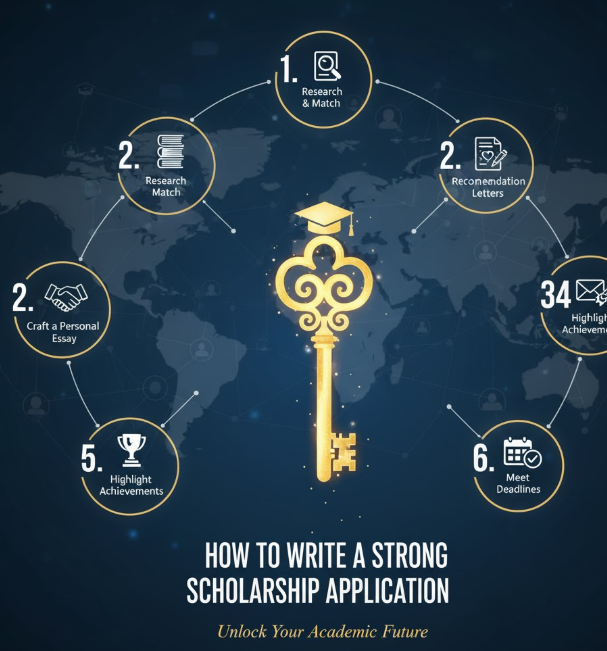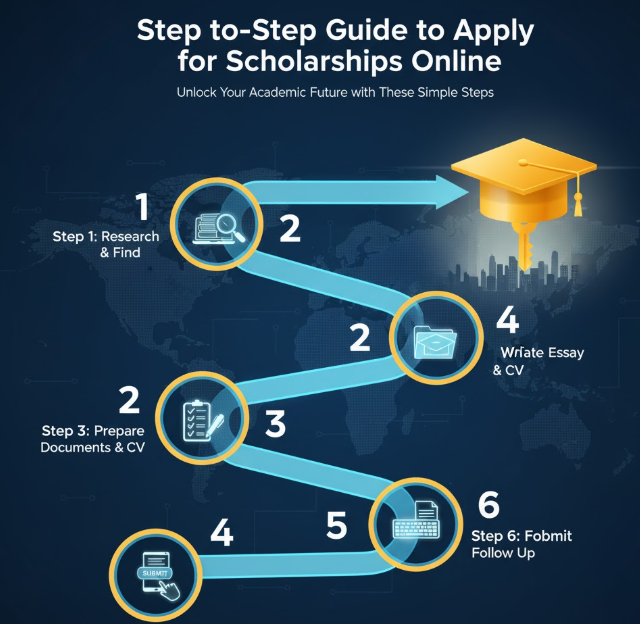Can you picture receiving thousands of dollars to put toward your college without ever having to pay it back? Scholarships do just that, but there’s a catch: You have to persuade someone you deserve it more than hundreds or thousands of other students. Sounds tough, right? It’s really not as terrifying as it looks.
Every year, millions of dollars in scholarship money goes unclaimed just because students don’t apply or aren’t sure how to make their application stand out. Whether it’s a full-ride scholarship to a state college, community college or university — or even a Seekers/Young Leaders Scholarship from the school of hard knocks — knowing how to write an application is a valuable skill that will pay dividends for your kids once they go off to school on their own.
This guide will take you through everything there is to know about constructing a scholarship application that’s memorable, presents your story in the best possible way and also lifts your chances of winning exponentially. We’ll go over the important parts, pitfalls to avoid and tricks that scholarship committees aren’t telling you. By the end, you’ll have a roadmap on how to turn your scholarship dreams into reality.
Why Strong Applications Matter
Before we get into the how-to, let’s talk about why it’s so critical to put some effort into your scholarship application. Dozens if not hundreds of applications are typically read by scholarship committees. Virtually all of them say the same thing: “I’m a hard worker, I get good grades and I need money for college.” While this stuff may be true, it’s not helping you to stand out from the crowd.
A great application is one that does three things: it grabs attention right from the start; it tells a memorable story about who you are and why you’re deserving of the scholarship; and, most importantly, it flat-out makes you the best possible candidate for that particular award. When cast properly, your application will cling to the reader long after they have finished it.
Know What You’re Applying For
The single greatest mistake students make is applying for all scholarships in the same way. They write one generic essay and send it to all the schools on their list, hoping that something will stick. It doesn’t work very often: Each scholarship has different goals, values and ideas of what makes a candidate ideal.
Do your homework. Read the scholarship description thoroughly before you write one word. Who’s offering it? What’s their mission? What sort of student are they trying to assist? Some concentrate on academic achievement, and others on community service, leadership, financial needs or particular career paths. Knowing it will help you customize your application to fit what they want.
Look over the requirements at least three times. Create a list of all that they are demanding: essays, letters of recommendation, transcripts, writing samples, activity lists — the works. Fail on even one small requirement and your application can be thrown out straight away, no matter how good the rest of it’s looking.
Building Your Personal Story
Every individual has an interesting story, and your scholarship application is your opportunity to tell yours. But here’s the secret: It’s not just what happened to you — it’s about what you learned, how much you’ve changed, and what are you going to do now because of that experience.
Begin with brainstorming some experiences in your past that influenced who you are today. These needn’t be dramatic or tragic. Perhaps you learned leadership by running a bake sale for your soccer team. Maybe you developed a passion for science while watching nature documentaries with your grandfather. Or perhaps you built resilience through relocating to a new school and having to start all over in the friend-making department.
Select stories that are relevant to the mission of the scholarship. If it’s a scholarship for future teachers, explain how you started volunteering at the elementary school and realized what an impact education could make. If it’s for students who have overcome obstacles, center on pieces of adversity you have faced and surmounted. Spell these connections out — don’t assume the reader will make them.
Creating a Killer Essay
Your essay is likely the most critical part of your application. It’s where your character comes through, and you have the chance to really distinguish yourself. And here’s how to make yours unforgettable.
Begin with a hook that serves to catch interest. Don’t open with “My name is…” or “this scholarship is beneficial because…” Instead of easing us into a moment, just throw the reader there: “The smell of antiseptic always makes me think about my grandmother’s hospital room and the day I knew I wanted to be a nurse.” Or “I had $4.27 and only an hour to sort out how we were going to feed 20 people at our community center.”
This strategy instantly makes your essay that much more interesting and delivers the reader with a reason to read on. After your lead, you can provide explanation and elaboration that directly connects to your key point.
Show, don’t tell throughout your essay. Don’t just say “I’m a hard worker.” Instead, share the story of how you spent three months teaching yourself code to create an app that helps students at your school find study partners. Don’t say “I care about my community.” Tell us about organizing a neighborhood cleanup that cleared 500 pounds of trash from a nearby park.
Support your response with precise details, numbers and examples. So rather than “I volunteered a lot,” you might start with: “I spent 150 hours over six months teaching elementary school students to read, and saw my student Maria gain the ability to handle basic words to cracking open chapter books.” It’s the details that make your memories feel alive.
The Perfect Application Timeline
When it comes to scholarships, timing is more important than most students know. Scholarship deadlines can sneak up on you, and there’s nothing worse than missing out on scholarship opportunities because it feels overwhelming. Here’s a timeline to help you stay on schedule:
| Timeline | Task | Why It Matters |
|---|---|---|
| 2-3 months before deadline | Research scholarships and make a list | Gives you time to find the best opportunities and prevents last-minute scramble |
| 6-8 weeks before | Ask for recommendation letters | Teachers and counselors need time to write letters of support |
| 4-6 weeks before | Write first draft of essays | Allows for multiple rounds of edits and improvement |
| 3-4 weeks before | Gather necessary documents (transcripts, test scores, etc.) | Some documents may take time to request or receive |
| 2-3 weeks before | Revise essays following feedback | Having fresh eyes catch mistakes and improve clarity |
| 1 week before | Final review/prepare for interviews if applicable | Catches any last-minute issues; builds confidence |
| 2–3 days before | Submit application | Provides buffer in case of technical difficulties |
Letters of Recommendation That Help
Recommendation letters are the make-or-break portion of an application, but so few students understand this. The trick is to find the right folks and make it easy for them to write you a dynamite letter.
Choose recommenders who are familiar with you and can address some of the traits that the scholarship is looking for. If you’re looking for a teacher recommendation, select someone whose class you did well in, and who saw you make progress or work through hardships. If you are applying to local scholarships, that could be a volunteer coordinator, coach or religious leader who has seen your influence up close.
Don’t just say, “Will you write me a recommendation?” Instead, what you want to ask is, “Would you feel comfortable writing me a strong recommendation letter for this scholarship?” This gives them an easy pass if they feel they can’t write something captivating, which is better than receiving a lukewarm recommendation.
Make it easy for them. Provide your recommenders with key information: details about the scholarship, your essay or personal statement, your resume and a brief summary of why you’re applying and why you’re qualified. This gives them material to work with and helps them write a more specific, compelling letter.
Your Activity List and Resume
The overwhelming majority of scholarship applications require an essay of some sort to be submitted, but some are more interested in a list of your activities, achievements and work record. But, this is more than just a boring list; it’s an opportunity for you to show off what makes you special!
Organize your activities into the following categories:
- Academic Achievements
- Leadership Positions
- Volunteer Experiences
- Work Experience
- Athletics and Arts
- Honors/Awards
In each category, rank the items that are most impressive or pertinent at the top of the list.
For each activity, include:
- The name of organization or activity
- Your role or position
- Dates of participation
- Hours per week or total hours
- Description of responsibilities and impact
Here’s the key: Focus on impact rather than just participation. Instead of “Member of National Honor Society” write “National Honor Society member; coordinated monthly tutoring sessions which assisted 15 students in raising their GPAs.” Instead of “Worked at restaurant,” for example, you might say something like, “Server at family restaurant; trained 6 new hires and increased customer satisfaction by delivering exceptional service.”
Quantify your accomplishments whenever possible. Numbers jump out of the page and make your successes tangible. “Raised $3,000 for a local animal shelter” is so much more impressive than “Fundraised for charity.”

The Financial Need Statement
If a scholarship wants to know about financial need, answer honestly and don’t get too personal or come across as begging. Clearly explain your family’s financial picture: household size, family income if you’re comfortable sharing it and specific challenges such as medical bills, supporting other relatives, or other siblings in college.
And most importantly, draw a direct connection from your financial need to how the scholarship will help you meet your goals. “This would cover my books and lab fees so I’d be able to take the science classes that are part of my pre-med itinerary without doing side shifts, which would take away from study time.”
Avoid being negative or complaining. Replace “My family is poor and can’t afford anything,” for example, with “I’m the first person in my family to go to college, so I’m figuring out how to afford college on my own without the help that a lot of other students have. This scholarship would allow me to work toward my degree instead of struggling to pay tuition on top of working 40 hours while also taking classes.”
Polish, Edit, and Perfect
Now that you’ve written everything, the hard part starts: editing. There is no good writing in the first draft, and it applies to scholarship essays. Here’s how to buff up your application until it sparkles:
Pause after your first draft. Wait at least 24 hours to reread your writing. This space allows you to see things that are wrong, or awkwardly phrased, that you’ve overlooked when you were joining all those atoms together.
Read your essay out loud. If you’re tripping over sentences or finding yourself out of breath, they’re likely too long or awkwardly worded. Your writing should be natural, as if you are speaking to someone.
Common problems to check for:
- Did you address the question that was asked?
- Is your essay the correct length (neither too short nor too long)?
- Were you focused on your central point or did you stray off topic?
- Is each paragraph relevant to your subject matter as a whole?
Get feedback from people who will tell you the truth. Have a teacher, counselor, parent or an older sibling who has applied to scholarships give you feedback on your essay. Ask them pointed questions: “Does this opening make you want to read more?” “Is my main point clear?” “Where were you confused?”
Easy Errors That Can Cost You a Scholarship
Basically, application killers—things that even if you still have all the qualifications in the world will get your application rejected:
Missing the deadline is enemy number one. You can have the most spectacular product ever developed but if it’s even one minute late, it will not be reviewed. Set reminders, physically mark your calendar and plan to send out at least a few days early.
Typos and grammatical errors also give you the appearance of being lazy. There’s one small typo you could overlook, but multiple mistakes suggest to me that you did not care enough to proofread. Spell check, pay attention and get another eye on that thing.
Using generic essays demonstrates superficial interest in the scholarship committee and the work they do. If the essay could apply to any scholarship, it’s not a good essay. The reader should know which specific scholarship you applied for from reading your essay.
Not complying with page limits or requirements is a disrespect to the committee’s time. If they want 500 words, don’t send in 800. So if they would like three particular questions answered, answer all three and not just the ones you fancy.
Misrepresentation or exaggeration will come back to bite you. Your information will likely be confirmed by the scholarship committee, and lies can make you lose a chance at scholarships or opportunities down the road. Be honest about your achievements—they speak for themselves.
Standing Out From the Competition
Now that we’ve discussed what you shouldn’t do, here’s how to really stand out in your application:
Find an unexpected angle. If all the other applicants are writing about their love of chemistry class, write about how your grandmother’s stories inspired you to learn more about history. If other people are talking about their 4.0 GPAs, share a disappointing grade you got in English and what it taught you about perseverance.
Show genuine passion. Committees can sense when you really care about something and when you’re just trying to impress them. Write about what really excites you and not just the plain or mundane. Authentic enthusiasm is contagious.
Demonstrate growth and self-awareness. The strongest applications will demonstrate not just what you’ve done but also how you’ve been changed and what you’ve learned about yourself. Discuss the mistakes you have made and what you learned from them. Describe how your goals have changed as you matured.
Tie everything toward what you are planning to do in the future. A scholarship committee is an investment in your future. Demonstrate how they will get a return on their investment in you by articulating what you want to accomplish and how you will make an impact in your profession or community.
Preparing for Scholarship Interviews
Interviews seem nerve-wracking, but are actually a fantastic opportunity to bring your application to life. Here’s how to prepare:
Review your application carefully before the interview. They will probably also ask you to elaborate on some of the things that you wrote, so be sure not only to remember what you said but also have other anecdotes and descriptions ready.
Anticipate common questions:
- What makes you deserving of this scholarship?
- What are your career goals?
- What’s your greatest achievement?
- Can you tell us about a challenge you’ve faced?
- How will you add to your college community?
Practice your responses out loud, but avoid memorization of scripts—you want to sound natural, not overly canned.
Look the part, get there early and take copies of your application with you. You only make a first impression once, and coming prepared is an act of maturity and respect.
During the interview, try to maintain eye contact, articulate well and take a moment to think about how best to answer challenging questions. It’s all right to take a breath, collect your thoughts — certainly beats rambling on. Just be yourself instead of trying to answer in a way you think they want to hear. Authenticity trumps polished perfection.
Applying to Multiple Scholarships
It’s risky to put all your eggs in one basket. The more scholarships you apply to, the greater your chances are of winning at least one. But how do you juggle multiple applications without burning out?
Create a master document that includes all your core information: personal story, major accomplishments, goals and some well-written paragraphs about various aspects of your life as well as interests. As new opportunities arise, you can extract sections that are relevant to a given new application from this document and adapt them instead of building each entirely from scratch.
Prioritize scholarships strategically. Apply to local scholarships first, which tend to have fewer applicants and therefore better odds for you. Prioritize scholarships that align with your interests, background or circumstances, even if they are for smaller amounts. Five $1,000 scholarships is no small amount — that’s a total of $5,000.
Create a spreadsheet to keep track of deadlines, requirements and the like. A straightforward spreadsheet is fine: name of the scholarship, amount, deadline, what you need to do for it (applicants often need to write an essay and obtain a transcript), when you transmitted your application and if anything was left outstanding. Manage your list by updating it frequently.
For more scholarship search resources, visit Fastweb to discover thousands of opportunities tailored to your profile.
After You Submit
Your job is not finished once you click submit. Send a thank-you email to anyone who wrote you a letter of reference. Tell them you applied and express heartfelt gratitude for their assistance.
If you are successful, send thank-you notes to the scholarship committee and inform your recommenders of the good news. Many scholarships will also require you to write a formal thank-you letter, or attend an awards ceremony so take these as seriously as the application itself.
Keep trying even if you don’t win. Request feedback if you can and apply what you’ve learned to be better at your next application. Every application you write will make you better at selling yourself on paper, which is a useful skill not just for applications to college, but also job hunting and beyond.
Keep applying. One student might win the first scholarship they apply for; another may apply to 50 before receiving one. Persistence pays off, and any hour you invest in applications could potentially generate hundreds or thousands of dollars in scholarship money.

Frequently Asked Questions
When can I begin searching for scholarships?
Begin your scholarship search as early as your sophomore year in high school, though the peak application period will be junior and senior year. Many scholarships offer application windows between 6-12 months out from your award date, so the earlier you start looking, the more you have to choose from and less stressed out about applying.
How many scholarships should I apply to?
There is no magic number, but a good rule of thumb is to apply for 10-15 scholarships. The more applications, the greater the chances of winning. Think of it this way: If you have a 10% chance of winning each scholarship, then putting in for 15 gives you far better odds than if you applied to three.
Is it okay to reuse the same essay for several scholarship applications?
You get to use the same general story or theme, but you have to adapt it to what that specific scholarship requires you to write about. Admissions committees can detect when an essay has been repurposed and it undermines your chances. Your answers should always be specific to each individual scholarship.
What if I don’t have perfect grades?
There are plenty of scholarships that don’t rely exclusively on grades either, such as community service, leadership, overcoming adversity or specific talent. Search for scholarships that match your strengths. Even for academic scholarships, a good essay and strong recommendations can occasionally eclipse an imperfect GPA — particularly if you can demonstrate that you’ve grown and improved.
Do I have to pay to apply for scholarships?
No true scholarship will ask you to pay any kind of application fee. If someone asks you to pay in order to apply for a scholarship or claim a scholarship, the request is a scam. Legitimate scholarships do not charge an application fee (though there may be fees to participate in competitions that technically are not scholarships).
How can I discover scholarships that suit my profile?
Search scholarship engines like Fastweb, Scholarships.com, and your school counselor’s resources. Also look into any organizations connected to your personal interests or history: Your parent’s employer, religious group, community club, professional association in your future field and local businesses often offer fewer-applicants scholarships.
Making It All Worth It
The strong scholarship application requires time, effort, and repeated revisions. You have to reflect on who you are, what you’ve achieved and where you’re going. Here’s the part that makes it all worth it, though: Every scholarship you earn is money you don’t have to borrow, which will leave you with less debt after college and more flexibility to live your dreams.
And, beyond money, if nothing else you’re getting a crash course in how to package yourself—writing about yourself and reflecting on what you want your life’s work to look like—that will continue to serve you long into college and maybe even into the rest of your career. You’re not just playing for money — you’re learning how to pitch a story about yourself, to advocate for what you need and want, and how to present your best self to the world.
Begin today, even if those deadlines still seem far away. Start researching scholarships that fit your profile, start brainstorming on your stories, and write that first essay. Small steps take you one step closer to your goal. Also, don’t forget that scholarships are awarded to thousands of students each year and there’s no reason you shouldn’t be one of those recipients!
Your education is an investment in your future, and scholarships are one way to make that investment a bit easier to afford. When you adhere to the advice, tactics, and best practices included here—writing powerful essays and choosing strong recommenders, assembling well-prepared materials and applying strategically—you’ve given yourself all of the best possible advantages.
The committee hasn’t met you yet, but the closest thing is your application. Make it count. Show them not just what you have done, but who you are and who you will be. Tell your story proudly, passionately and honestly. And whatever you do, don’t quit. Your ideal scholarship is waiting for you to apply.




